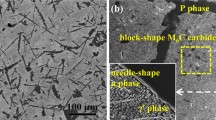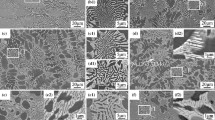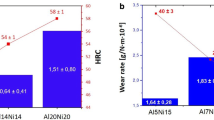The NiAl/Cr(Mo,Dy) hypoeutectic alloy was prepared by quasi-rapid solidification to investigate its microstructure and wear behavior. The results revealed that the quasi-rapid solidification refined the eutectic cell and NiAl/Cr(Mo) eutectic structure obviously. The alloy was composed of primary NiAl, fine NiAl/Cr(Mo) eutectic lamella and Ni 5 Dy phase. Compression test showed that the quasi-rapid solidification improved the mechanical properties of the alloy obviously. Wear test exhibited that alloy possessed excellent wear properties at about 1073 K, which should be ascribed to the lubricant film formed by amorphous and Cr 2 O 3 and Al 2 O 3 nanoparticles. The alloy also exhibited relative good wear properties at 673 K, which should be attributed to its high strength.
Similar content being viewed by others
Explore related subjects
Discover the latest articles, news and stories from top researchers in related subjects.Avoid common mistakes on your manuscript.
Introduction. Nickel aluminum (NiAl) has been paid much attention, because of its excellent properties at high temperatures, and it has been treated as a promising structural material to use in aircraft engines [1–3]. However, its insufficient high-temperature strength and room-temperature brittleness impedes its application. Recent investigations [4, 5] have revealed that introducing of ductile phase in NiAl can improve its mechanical properties, which is instrumental for developmen t many kinds of NiAl-based materials. Among them, NiAl/Cr(Mo) eutectic alloy with a lamellar eutectic structure becomes attractive, because of its good balance of room- and hightemperature properties [6–8]. In spite of its enhanced mechanical properties [9], its high-temperature creep property is still lower than that of the Ni-based superalloy [10, 11]. The recent studies [12] confirm that the introducing of rare earth (RE) element is beneficial for high-temperature properties, while the RE segregating along eutectic cell boundary leads to a sharp reduction of its compressive ductility. The results of research [13] indicate that a rapid solidification can homogenize the distribution of RE and then increase the room-temperature compressive ductility. Moreover, previous research [14] has exploed the tribological behavior of NiAl and exhibited its good tribological properties. However, few works have been dedicated to wear behavior of NiAl/Cr(Mo) eutectic alloy. Recently, it was reported that the oxide is helpful to the tribological properties by forming a glaze film [15], while studies [16, 17] indicate that addition of rare earth to NiAl/Cr(Mo) eutectic alloy can result in oxide formation. Furthermore, the increase of NiAl phase can promote the formation of alumina, and thus benefit to the wear properties. Therefore, in the present paper, the NiAl/Cr(Mo,Dy) hypoeutectic alloy is fabricated by quasi-rapid solidification, and its microstructure and wear behavior at elevated temperature are investigated.
1. Experimental Procedure. The alloy with composition of Ni–35Al–24Cr–5Mo–0.1Dy (at.%) weas melted in vacuum from pure metal chromium (99.9%), nickel (99.9%), dysprosium (99.8%), aluminum (99.9%) and molybdenum (99.8%). To obtain the homogeneous samples, the alloy tablets were remelted and turned over for four times. The alloy was cut into pieces for quasi-rapid solidification. These pieces were put into a quartz tube and re-melted by induction coil; after then it was injected into a Cu mold (∅10 mm) to obtain the quasi-rapid solidified alloy.
Specimens for microstructure characterization, wear and mechanical properties tests were cut out from the quasi-rapid solidified alloy sample. The Phenom™ Pro scanning electron microscopy (SEM) was used to perform microstructure characterization. The constitute phase composition of the alloy was analyzed by the EPMA-1610 electronic probe microanalysis. JEOL-2100 transmission electron microscope (TEM) was employed to carryout the TEM characterization, and the respective specimen was cut from alloy blank with the thickness of 0.4 mm. Then the specimen was polished to 30 μm and shaped into ∅3 mm in size with the following twin-jet electropolishing. The compression specimen (4 × 4 × 6 mm) was cut from the composite and mechanically grounded by 800-grit SiC abrasive. Gleeble 3800 was employed to conduct the compression test at the strain rate of 1∙10−3s-1. Dry sliding wear test was carried out on a HT-1000 type test machine, with the quasi-rapid solidified alloy pin rubbing against a SiC disk [14]. The wear test was performed at a linear speed of 0.2 m/s for 100 min under the load of 30 N in air at different temperatures. Wear rate is presented in terms of the friction coefficient by normalizing the volume loss by load and sliding distance. SEM and TEM were applied to observe the worn surface and the cross section of the specimen.
2. Results and Discussion.
2.1. Microstructure and Compressive Properties. Microstructure of NiAl/Cr(Mo,Dy) hypoeutectic alloy prepared by quasi-rapid solidification is exhibited in Fig. 1. Clearly, grey α-Cr phase and black NiAl matrix are the main components that comprise the eutectic cell and coarse intercellular zone, as shown in Fig. 1a and 1b. In the eutectic cell, α-Cr and NiAl lamellas extend from the center to the boundary. The thickness of the eutectic lamella near the boundary is larger than that in the center. Along the eutectic cell boundary, a small white phase can be observed, and the energy disperse spectroscopy (EDS) analysis exhibits it mainly contains Dy and Ni. TEM and selected area diffraction pattern (SADP) examinations of the phase along the eutectic cell boundary confirm it to be Ni5Dy with a hexagonal crystal structure (a = 0.4856 nm, c = 0.3969 nm) and P6/mmm space group, as shown in Fig. 1c. TEM observation also revealed that the small precipitates were distributed in α-Cr and NiAl phases, which should be β-NiAl and α-Cr particle precipitates, respectively. Moreover, further observation of the eutectic cell revealed the interface dislocations with hundreds nanometer in width at the phase boundary, as shown in Fig. 1d.
SEM image of quasi-rapidly solidified NiAl/Cr(Mo,Dy) hypoeutectic alloy (a); morphology of Ni5Dy phase along eutectic cell boundary (b); TEM morphology of Ni5Dy and precipitates in α-Cr phase (inset picture showing SADP of Ni5Dy phase) (c); TEM image of interface dislocation along NiAl/α-Cr phase boundary (d).
The compressive yield strength variation of binary NiAl alloy and NiAl/Cr(Mo,Dy) hypoeutectic alloy prepared by quasi-rapid solidification at elevated temperatures is shown in Fig. 2. Clearly, with the temperature increase, the yield strength of both alloys decreases gradually. However, as compared with the binary NiAl alloy, the reduction rate of quasi-rapidly solidified NiAl/Cr(Mo,Dy) hypoeutectic alloy is higher, especially between 600 and 900 K. Moreover, the rapid solidification and strengthening phase strongly improved the yield strength of NiAl/Cr(Mo,Dy) hypoeutectic alloy, which at 1273 K is almost the same with that of binary NiAl alloy at 673 K. The improved yield strength of NiAl/Cr(Mo,Dy) hypoeutectic alloy should be attributed to the α-Cr phase and the refined eutectic structure induced by the quasi-rapid solidification.
2.2. Wear Properties. The average friction coefficient and wear rate of NiAl/Cr(Mo,Dy) hypoeutectic alloy prepared by quasi-rapid solidification changes obviously with the temperature, as shown in Fig. 3. With the temperature increase, the friction coefficient has two valley values at 673 and 1073 K, respectively. The friction coefficient reaches its minimum value at 1073 K. The evolution of the wear rate is different from the friction coefficient. It keeps the uptrend with temperature increase but drops sharply at 1073 K. The wear rate attains the minimum value at 1073 K.
2.3. Worn Surface. To explain the above variation of the wear properties, observation of the worn surface of NiAl/Cr(Mo,Dy) hypoeutectic alloy fabricated by quasi-rapid solidification was carried out. Figure 4 shows the typical morphology of the worn specimen at elevated temperatures. At relatively low temperature, a scratch resulted by abrasion is the main characteristic, as shown in Fig. 4a. Due to the alloy brittleness at low temperatures, debris and cracks can be found at the worn surface. When the temperature increases to 673 K, the worn surfaces demonstrate the rheology feature, as shown in Fig. 4b. When the temperature increases to 873 K, fa urrow becomes the main characteristic, as shown in Fig. 4c. The deep furrows at the worn surface can explain the peak value of wear rate and friction coefficient at this temperature. With the temperature attaining 1073 K, the worn surface is smooth and has no furrow, as shown in Fig. 4d. When the temperature increases further, the worn surface is spalled partly by the friction pair and exhibits a ripple morphology, as shown in Fig. 4e. SEM observation of the worn specimen at 1073 K reveals that a relatively thick lubricant film with several micrometers in size is generated an the surface of the matrix, as shown in Fig. 4f. The observation also exhibits that the matrix near the worn surface has experienced a high deformation. The inset SADP reveals that the lubricant film is mainly composed of Cr2O3 amorphous phase and Al2O3 nanocrystalline particles.
According to the recent studies [18, 19], the material wear properties are related to its strength and tribological product. A high strength can improve the wear resistance, while debris can introduce the self-lubricating medium. In the present paper, the quasi-rapid solidification improved the strength of NiAl/Cr(Mo,Dy) hypoeutectic alloy obviously. The formation of oxides of Ni, Al and Cr introduces the self-lubricating medium, which is helpful to decrease the wear rate and friction coefficient. But at the lower temperature, the brittle NiAl phase can not withstand the long-term grind, which results in the formation of a microcrack. Though the increased temperature can enhance the self-lubricating medium, the stiff matrix can not take advantage of this. Therefore, the friction coefficient decreases, but the wear rate increases below 673 K. When the testing temperature increases further, it will exceed the ductile-to-brittle transition temperature, so the NiAl matrix becomes softer. Then one can see that the friction coefficient and wear rate both exhibit and obvious ascend tendency in the range of 673 to 873 K. At 1073 K, the selflubricating medium forms a lubricant film at the worn surface, which strongly reduces the wear rate and friction coefficient. If the test temperature becomes higher, the matrix can not support the lubricant film for a long time, and this results in the spalling of the worn surface. It can be deduced that at low temperature, the microfracture is the main characteristic, while strength plays a dominant role. At high temperature, oxidation and self-lubrication are the main mechanisms controlling this process.
CONCLUSIONS
-
1.
A NiAl/Cr(Mo,Dy) hypoeutectic alloy, which consists of fine NiAl/Cr(Mo) eutectic lamella, primary NiAl, Ni5Dy phase, was fabricated by quasi-rapid solidification. The compressive properties of NiAl/Cr(Mo,Dy) hypoeutectic alloy are improved by the quasi-rapid solidification.
-
2.
The NiAl/Cr(Mo,Dy) hypoeutectic alloy prepared by quasi-rapid solidification exhibits a relatively good wear properties below 673 K and excellent wear properties at the temperature of 1073 K.
-
3.
The excellent wear properties at high temperature can be ascribed to the protecting lubricant film, which is composed of amorphous and Cr2O3 and Al2O3 nanoparticles. Relatively good wear properties at low temperature can be attributed to the high strength of the alloy.
References
D. B. Miracle, “Overview No. 104 the physical and mechanical properties of NiAl,” Acta Metal. Mater., 41, No. 3, 649–684 (1993).
L. Y. Sheng, W. Zhang, J. T. Guo, et al., “Effect of Au addition on the microstructure and mechanical properties of NiAl intermetallic compound,” Intermetallics, 18, No. 4, 740–744 (2010).
H. Q. Ye, “Recent developments in high temperature intermetallics research in China,” Intermetallics, 8, No. 5–6, 503–509 (2000).
L. Y. Sheng, Y. Xie, T. F. Xi, et al., “Microstructure characteristics and compressive properties of NiAlbased multiphase alloy during heat treatments,” Mater. Sci. Eng. A, 528, No. 29–30, 8324–8331 (2011).
L. Y. Sheng, W. Zhang, J. T. Guo, et al., “Microstructure evolution and mechanical properties’ improvement of NiAl-Cr(Mo)-Hf eutectic alloy during suction casting and subsequent HIP treatment,” Intermetallics, 17, No. 12, 1115–1119 (2009).
H. Bei and E. P. George, “Microstructures and mechanical properties of a directionally solidified NiAl–Mo eutectic alloy,” Acta Mater., 53, No. 1, 69–77 (2005).
L. Y. Sheng, J. T. Guo, T. F. Xi, et al., “ZrO2 strengthened NiAl/Cr(Mo,Hf) composite fabricated by powder metallurgy,” Prog. Nat. Sci.-Mater. Int., 22, No. 3, 231–236 (2012).
D. R. Johnson, X. F. Chen, B. F. Oliver, et al., “Processing and mechanical properties of in-situ composites from the NiAl-Cr and the NiAl-(Cr,Mo) eutectic systems,” Intermetallics, 3, No. 2, 99–113 (1995).
L. Y. Sheng, L. Nan, W. Zhang, et al., “Microstructure and mechanical properties determined in compressive tests of quasi-rapidly solidified NiAl-Cr(Mo)-Hf eutectic alloy after hot isostatic pressure and high temperature treatments,” J. Mater. Eng. Perform., 19, No. 5, 732–736 (2010).
L. Y. Sheng, F. Yang, J. T. Guo, and T. F. Xi, “Anomalous yield and intermediate temperature brittleness behaviors of directionally solidified nickel-based superalloy,” Trans. Nonferr. Met. Soc. China, 24, No. 3, 673–681 (2014).
L. Y. Sheng, F. Yang, T. F. Xi, et al., “Microstructure and elevated temperature tensile behaviour of directionally solidified nickel based superalloy,” Mater. Res. Innov., 17, No. S1, 101–106 (2013).
L. Y. Sheng, F. Yang, T. F. Xi, et al., “Microstructure and room temperature mechanical properties of NiAl-Cr(Mo)-(Hf,Dy) hypoeutectic alloy prepared by injection casting,” Trans. Nonferr. Met. Soc. China, 23, No. 4, 983–990 (2013).
L. Y. Sheng, F. Yang, T. F. Xi, et al., “Improvement of compressive strength and ductility in NiAl–Cr(Nb)/Dy alloy by rapid solidification and HIP treatment,” Intermetallics, 27, 14–20 (2012).
J. A. Hawk and D. E. Alman, “Abrasive wear behavior of NiAl and NiAl–TiB2 composites,” Wear, 225–229, Part 1, 544–556 (1999).
O. Ozdemir, S. Zeytin, and C. Bindal, “Tribological properties of NiAl produced by pressure-assisted combustion synthesis,” Wear, 265, No. 7–8, 979–985 (2008).
L. Y. Sheng, L. J. Wang, T. F. Xi, et al., “Microstructure, precipitates and compressive properties of various holmium doped NiAl/Cr(Mo,Hf) eutectic alloys,” Mater. Des., 32, No. 10, 4810–4817 (2011).
L. Y. Sheng, J. T. Guo, Y. X. Tian, et al., “Microstructure and mechanical properties of rapidly solidified NiAl–Cr(Mo) eutectic alloy doped with trace Dy,” J. Alloy Compd., 475, No. 1–2, 730–734 (2009).
L. Y. Sheng, C. Lai, F. Yang, et al., “Microstructure and wear behaviour of ceramic particles strengthening NiAl based composite,” Mater. Res. Innov., 18, No. S4, 544–549 (2014).
T. Aizawa, A. Mitsuo, S. Yamamoto, et al., “Self-lubrication mechanism via the in situ formed lubricious oxide tribofilm,” Wear, 259, No. 1–6, 708–718 (2005).
Acknowledgments
The authors are grateful to the Strategic New Industry Development Special Foundation of Shenzhen (JCYJ20140419114548515), the Shenzhen International Cooperative Research Project (GJHZ20140419114548516) and the Shenzhen Technology Innovation Plan (CXZZ20140419114548507) for financial support.
Author information
Authors and Affiliations
Corresponding author
Additional information
Translated from Problemy Prochnosti, No. 1, pp. 124 – 129, January – February, 2016.
Rights and permissions
About this article
Cite this article
Sheng, L.Y. Microstructure and Wear Properties of the Quasi-Rapidly Solidified NiAl/Cr(Mo,Dy) Hypoeutectic Alloy. Strength Mater 48, 107–112 (2016). https://doi.org/10.1007/s11223-016-9744-5
Received:
Published:
Issue Date:
DOI: https://doi.org/10.1007/s11223-016-9744-5








